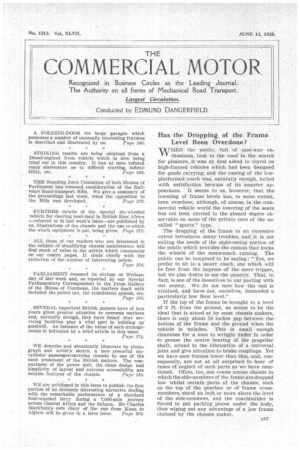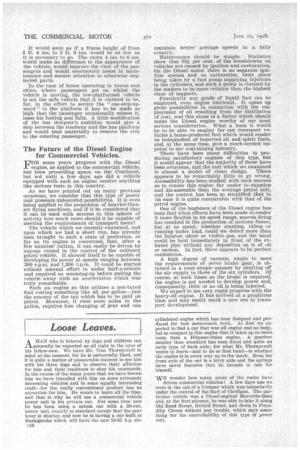Has the Dropping of the Frame Level Been Overdone?
Page 39

Page 40

If you've noticed an error in this article please click here to report it so we can fix it.
NUEEN the public, • full of post-war_ enthusiasm, tookto the road in the search for pleasure, it was at first asked to travel on high-framed • vehicles which had been designed for goods earrying,. and the coming of the lowplatformed coach was, naturally enough, hailed with satisfaction because of its 'smarter appearance. • It seems to us, however, that the lowering of frathe levels has, to some extent, been overdone, although, of course, in the commercial vehicle world the lowering of the seats has not been carried to the absurd degree observable on some of the private cars of the socalled " sports " type.
The dropping of the frame to an excessive extent introduces. many troubles, and it is not suiting the needs of the sight-seeing portion of the public. which provides the custom that keeps the wheels of the motorcoach turning. The public can be imagined to be saying: "Yes,, we prefer to sit in a smart coach, one which will be free from the impress of the mere tripper, but we also desire to see thecountry. That, in fact, is one of the incentives to our parting with our money. We do not care how the end is attained, and have not, ourselves, demanded a • particularly low floor level."
If the top of the frame be brought to a level of 2 ft. from the ground, as seems to be the ideal that is aimed at by most chassis makers, there is only about 18 inches gap between the bottom of the frame and the ground when the vehicle is unladen. This is small enough clearance for a man to wriggle under in order to grease the centre bearing of the propeller shaft, attend to the lubrication of a universal joint and give attention to brake couplings. Yet we have seen frames lower than this, and, consequently, are not at all surprised to hear of cases of neglect of such parts as we have mentioned. Often, too, one comes across chassis in which the side-members of the frame are dropped low whilst certain parts of the chassis, such as the top of the gearbox or of frame crossmembers, stand an inch or more above the level of the side-members, and the coachbuilder is forced to put packing pieces under the body, thus wiping out any advantage of a low frame claimed by the chassis maker.
It would seem as if a frame height of from 2 ft. 4 ins, to 2 ft. 6 ins, would be as low as it is necessary to go. The extra 4 ins. to 6 ins. would make no difference to the appearance of the vehicle, would improve the view of the passengers and would enormously assist in maintenance and ensure attention to otherwise neglected parts.
In the case of buses operating in towns and cities, where passengers get on whilst the vehicle is moving, the low-platformed vehicle is not the safe vehicle that it is claimed to be, for, in the effort -to secure the " one-step-upward " to the platform it has to be made so, high that the passenger occasionally misses it, loses his footing and falls. A little modification
of the bus designer's ambition would give a•step between the roadway and the bus platform
and would tend materially to remove the risk to the entering passenger.
The Future of the Diesel Engine for Commercial Vehicles.
PR some years progress with the Diesel engine, as applied to the commercial vehicle, has been proceeding apace on the Continent, but not until a few days ago did a vehicle equipped with such an engine receive anything like serious tests in this country.
As we have pointed out on many previous occasions, we consider that this type of power unit presents unbounded possibilities. It is even being applied to the propulsion of heavier-thanair flying machines, and if it be considered that it can be used with success in this sphere of activity how much more should it be capable of meeting the requirements of transport users?
The vehicle which we recently examined, and upon which we had a short run, has already been brought to such a state of perfection, so far as its engine is concerned, that, after a few minutes' tuition, it can easily be driven by anyone versed in the control of the ordinary petrol vehicle. It showed itself to be capable of developing its power at speeds ranging between 300 r.p.m. and 1,300 r.p.m. It could be started without manual effort in under half-a-minute and required no warming-up before pulling the vehicle away with an acceleration which was truly remarkable.
Such an engine as this utilizes a non-taxed fuel costing something like 4d. per gallon—just the amount of the tax which has to be paid on petrol. Moreover, it runs more miles to the gallon, requires less changing of gear and can maintain better average speeds in a hilly country.
Maintenance should be simple. Statistics show that 33* per cent. of the breakdowns on vehicles are caused by ignition and carburation. On the Diesel motor there is no separate ignition system and no carburetter, their place being taken by a fuel pump supplying injectors in the cylinders, and such a pump is claimed by the makers to be more reliable than the highest class of magneto.
Practically any grade of liquid fuel can be employed, even engine lubricant. It opens up great possibilities in connection with the employment of oil resulting from the distillation of coal, and this alone is a factor which should make the Diesel engine worthy of our most serious consideration. What a boon it would be to be able to employ for our transport vehicles a home-produced fuel which would render us independent of imported oil and spirit fuels, and, at the same time, give a much-needed impetus to our coal-mining industry.
There have been many difficulties in producing satisfactory engines of this type, but it would appear that the majority of these have been overcome, and the unit which we examined is almost a model of clean design. There appears to be remarkably little to go wrong. Accessibility has been studied with such success as to render this engine far easier to examine and dis-assembie than the average petrol unit, and the control has been so simplified that in its ease it is quite comparable with that of the petrol engine. One of the bugbears of the Diesel engine has been that when efforts have been made to render It more flexible in Its speed range, uneven firing has resulted in the production of noxious fumes, but at no speed, whether starting, idling or running under load, could we detect more than the faintest odour or visible gas, and the hand could be held immediately id front of the exhaust pipe without any deposition on it of oil or carbon. In fact, there appears to be perfect combustion.
A high degree of vacuum, ample to meet the requirements of servo brake gear, is obtained in a most simple manner by shutting off the air supply to three of the six cylinders. Of course, at such times as the brake is required, the engine is not needed to develop power and, consequently, little or no oil is being injected.
We expect to see very rapid progress with the heavy-oil engine. It has arrived at a propitious time and may easily mark a new era in transport development.












































































































